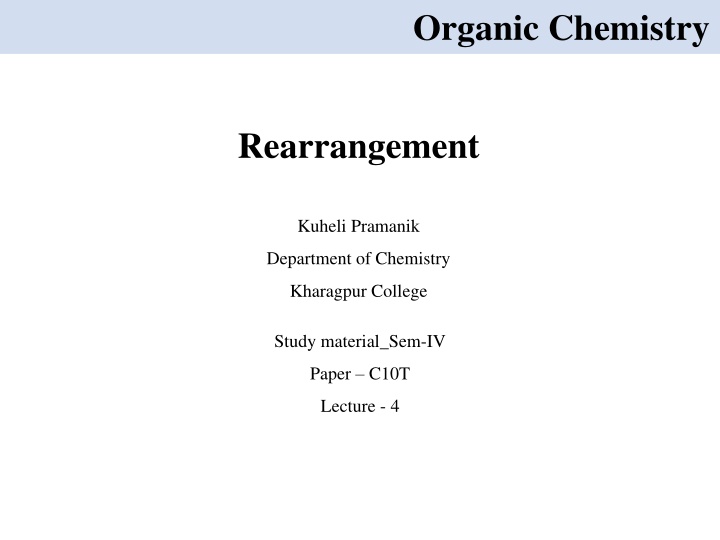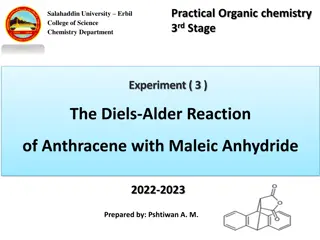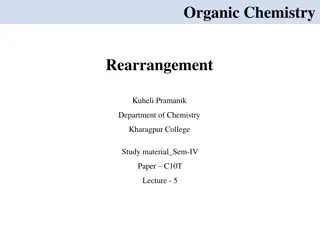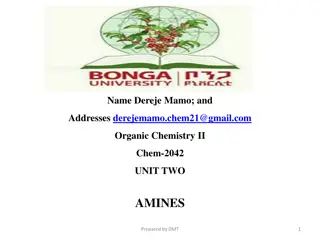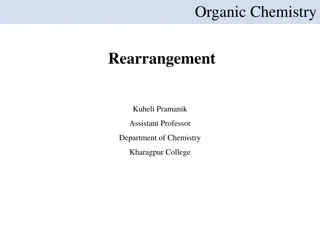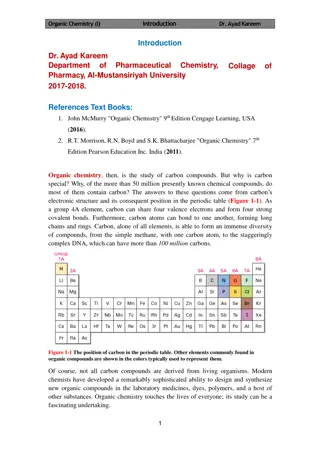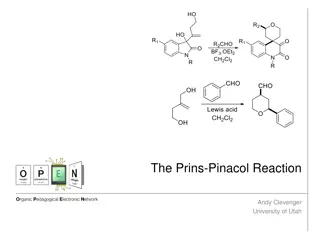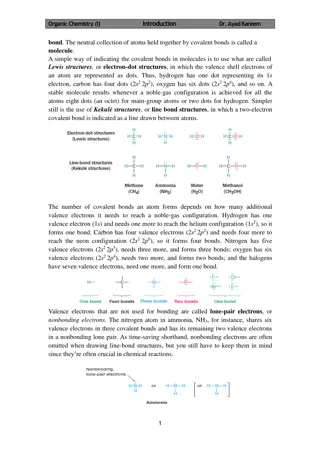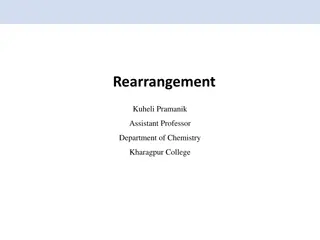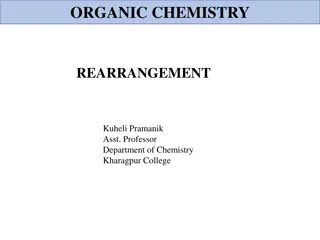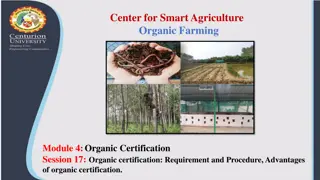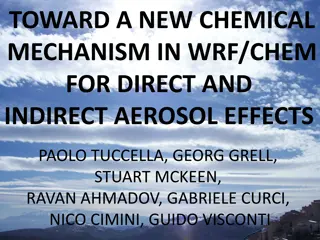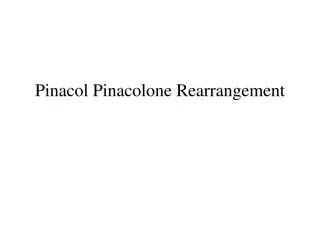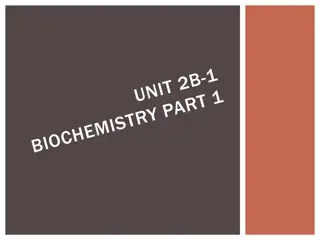Dakin Rearrangement in Organic Chemistry: Mechanism and Positional Effects
The Dakin Rearrangement, also known as Dakin oxidation, is an organic redox reaction involving hydroxylated phenyl aldehydes or ketones reacting with hydrogen peroxide to form benzenediols and carboxylates. The mechanism includes nucleophilic addition, [1,2]-aryl migration, and final product formation. Positional effects reveal that O-hydroxy compounds oxidize faster than p-hydroxy compounds due to the electrophilicity of the carbonyl carbon. M-hydroxy compounds lead to phenyl carboxylic acids instead of benzenediols and carboxylates due to variations in migratory aptitudes.
Download Presentation

Please find below an Image/Link to download the presentation.
The content on the website is provided AS IS for your information and personal use only. It may not be sold, licensed, or shared on other websites without obtaining consent from the author.If you encounter any issues during the download, it is possible that the publisher has removed the file from their server.
You are allowed to download the files provided on this website for personal or commercial use, subject to the condition that they are used lawfully. All files are the property of their respective owners.
The content on the website is provided AS IS for your information and personal use only. It may not be sold, licensed, or shared on other websites without obtaining consent from the author.
E N D
Presentation Transcript
Organic Chemistry Rearrangement Kuheli Pramanik Department of Chemistry Kharagpur College Study material_Sem-IV Paper C10T Lecture - 4
Dakin Rearrangement The Dakin Rearrangement (or Dakin oxidation or Dakin reaction) is an organic redox reaction in which an ortho- or para-hydroxylated phenyl aldehyde (2-hydroxybenzaldehyde or 4-hydroxybenzaldehyde) or ketone reacts with hydrogen peroxide in base to form a benzenediol and a carboxylate. Overall, the carbonyl group is oxidized, and the hydrogen peroxide is reduced. A typical example is given below.
Mechanism The Dakin oxidation starts with nucleophilic addition of a hydroperoxide anion to the carbonyl carbon, forming a tetrahedral intermediate (2). The intermediate collapses, causing [1,2]-aryl migration, hydroxide elimination, and formation of a phenyl ester (3). The phenyl ester is subsequently hydrolyzed: nucleophilic addition of hydroxide from solution to the ester carbonyl carbon forms a second tetrahedral intermediate (4), which collapses, eliminating a phenoxide and forming a carboxylic acid (5). Finally, the phenoxide extracts the acidic hydrogen from the carboxylic acid, yielding the dihydroxy products (6)
Positional effect O-hydroxy phenyl aldehydes and ketones oxidize faster than p-hydroxy phenyl aldehydes and ketones in weakly basic conditions. In o-hydroxy compounds, when the hydroxyl group is protonated, an intramolecular hydrogen bond can form between the hydroxyl hydrogen and the carbonyl oxygen, stabilizing a resonance structure with positive charge on the carbonyl carbon, thus increasing the carbonyl carbon s electrophilicity (7). Lacking this stabilization, the carbonyl carbon of p-hydroxy compounds is less electrophilic. Therefore, o-hydroxy compounds are oxidized faster than p-hydroxy compounds when the hydroxyl group is protonated.
Positional effect M-hydroxy compounds do not oxidize to m-benzenediols and carboxylates. Rather, they form phenyl carboxylic acids. Variations in the aryl rings' migratory aptitudes can explain this. Hydroxyl groups ortho or para to the carbonyl group concentrate electron density at the aryl carbon bonded to the carbonyl carbon (10c, 11d). Phenyl groups have low migratory aptitude, but higher electron density at the migrating carbon increases migratory aptitude, facilitating [1,2]-aryl migration and allowing the reaction to continue. M-hydroxy compounds do not concentrate electron density at the migrating carbon (12a, 12b, 12c, 12d); their aryl groups' migratory aptitude remains low. The benzylic hydrogen, which has the highest migratory aptitude, migrates instead (8), forming a phenyl carboxylic acid (9)
Electronic effect Substitution of phenyl hydrogens with electron-donating groups ortho or para to the carbonyl group increases electron density at the migrating carbon, promotes [1,2]-aryl migration, and accelerates oxidation. Substitution with electron-donating groups meta to the carbonyl group does not change electron density at the migrating carbon; because unsubstituted phenyl group migratory aptitude is low, hydrogen migration dominates. Substitution with electron- withdrawing groups ortho or para to the carbonyl decreases electron density at the migrating carbon (13c), inhibits [1,2]-aryl migration, and favors hydrogen migration
Acid-catalyzed Dakin oxidation The Dakin oxidation can occur in mild acidic conditions as well, with a mechanism analogous to the base-catalyzed mechanism. In methanol, hydrogen peroxide, and catalytic sulfuric acid, the carbonyl oxygen is protonated (14), after which hydrogen peroxide adds as a nucleophile to the carbonyl carbon, forming a tetrahedral intermediate (15). Following an intramolecular proton transfer (16,17), the tetrahedral intermediate collapses, [1,2]-aryl migration occurs, and water is eliminated (18). Nucleophilic addition of methanol to the carbonyl carbon forms another tetrahedral intermediate (19). Following a second intramolecular proton transfer (20,21), the tetrahedral intermediate collapses, eliminating a phenol and forming an ester protonated at the carbonyl oxygen (22). Finally, deprotonation of the carbonyl oxygen yields the collected products and regenerates the acid catalyst (23)
Cumene Hydroperoxide Rearrangement The cumene process (cumene-phenol process, Hock process) is an industrial process for synthesizing two valuable compound phenol and acetone from two relatively cheap compound benzene and propylene. Other reactants required are oxygen from air and small amounts of a radical initiator. In this process, cumene is oxidized in air to form a cumene radical, which gives cumene peroxide radical in presence of air, and then by abstracting a benzylic hydrogen from another cumene molecule it forms cumene hydroperoxide. cumene cumene hydroperoxide
Cumene Hydroperoxide Rearrangement The hydroperoxide to phenol conversion step involves a 1,2-shift of Ph group to an electron deficient oxygen atom (similar to Bayer-Villiger mechanism). 1,2-migration step (similar to Bayer-Villiger mechanism).
